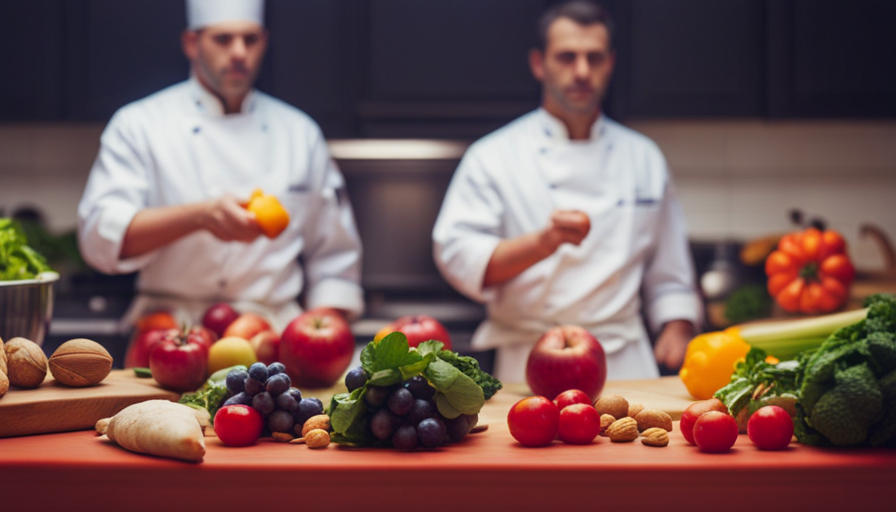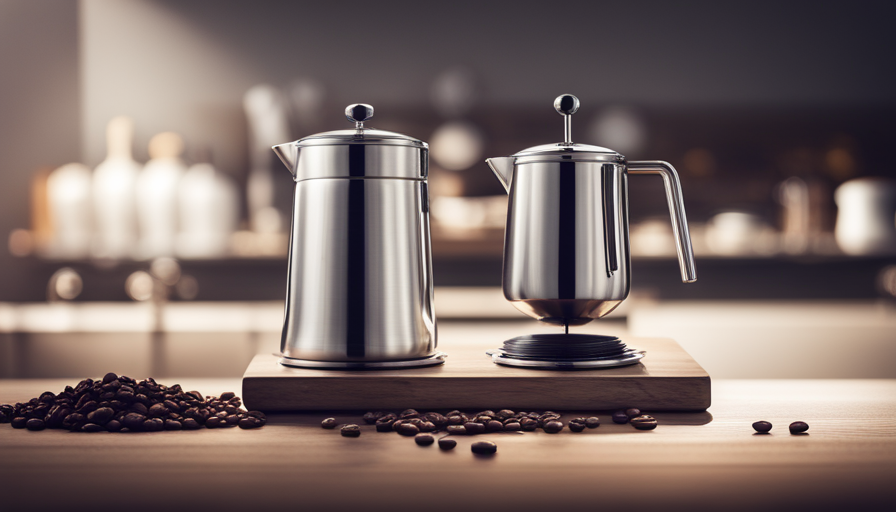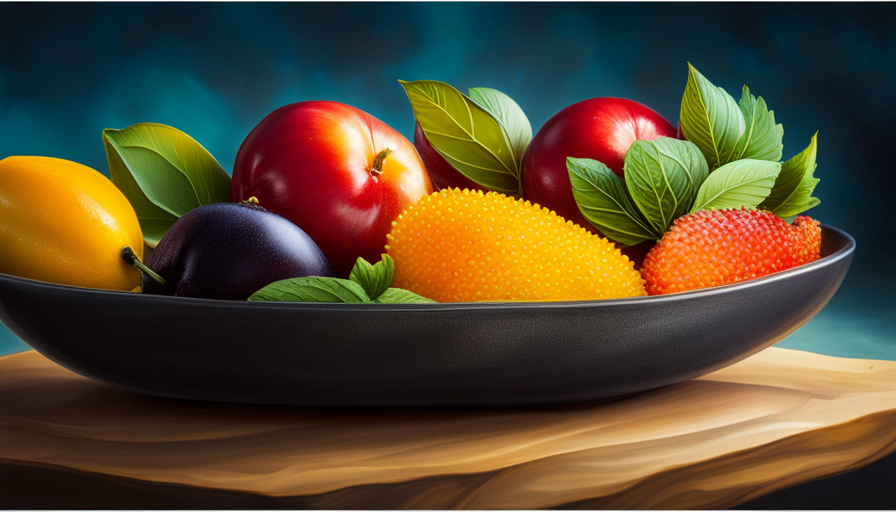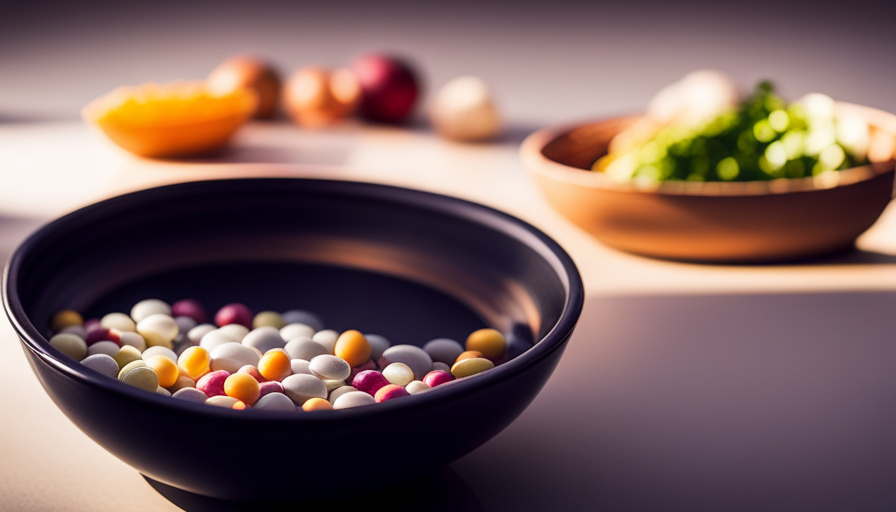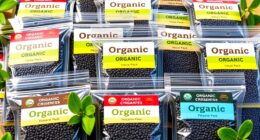Have you ever pondered why certain individuals opt to consume raw vegan cuisine? I once shared the same curiosity until I explored the principles behind this dietary decision. Raw veganism encompasses more than just food choices; it embodies a lifestyle that advocates for health, sustainability, and ethical values.
In this article, we will explore the reasons why cooking some food is not preferred by raw vegans and the benefits they claim to experience. From increased intake of enzymes and antioxidants to improved digestion and weight loss, there are various reasons why individuals choose to embrace this diet.
Additionally, we will discuss the environmental and ethical considerations that come with consuming raw vegan foods. If you’re curious about incorporating more raw vegan options into your diet or simply want to understand this lifestyle better, keep reading to discover the world of raw veganism.
Key Takeaways
- Raw veganism promotes health, sustainability, and ethical considerations by emphasizing whole, unprocessed foods without cooking or heating them.
- Raw veganism preserves the nutrients and enzymes in foods, leading to improved health, vitality, and a stronger immune system.
- Raw vegan foods are rich in antioxidants, which help fight free radicals and reduce the risk of chronic diseases.
- Raw veganism improves digestion and gut health through the consumption of fermented foods and the importance of fiber.
The Philosophy Behind Raw Veganism
So, why do I choose to follow a raw vegan lifestyle? The philosophy behind raw veganism is deeply rooted in the ethics of animal rights and environmental sustainability. By choosing to eat only raw, plant-based foods, I’m contributing to a more compassionate and sustainable world.
Raw veganism promotes the belief that animals shouldn’t be harmed or exploited for food, and that we should strive to minimize our carbon footprint by consuming foods that require minimal processing and transportation.
One of the key aspects of raw veganism is the emphasis on eating whole, unprocessed foods. Raw vegan recipes often include fruits, vegetables, nuts, and seeds in their natural state, without cooking or heating them. This is believed to preserve the nutrients and enzymes present in these foods, which can be destroyed through cooking. Proponents of raw veganism argue that this allows for better absorption of vitamins, minerals, and antioxidants, leading to improved health and vitality.
Transitioning to the subsequent section about the nutritional benefits of raw vegan cuisine, it’s important to note that while there are potential benefits to a raw vegan diet, it’s essential to ensure that one is meeting their nutritional needs.
Nutritional Benefits of Raw Vegan Cuisine
Indulge in the vibrant flavors and endless health benefits of nutrient-rich, unprocessed plant-based meals. Raw vegan cuisine offers a multitude of nutritional advantages that can enhance your overall well-being.
Here are four key benefits of incorporating raw veganism into your diet:
-
Increased Nutrient Density: Raw vegan food recipes retain the maximum amount of nutrients, as cooking can lead to nutrient loss. By consuming raw fruits, vegetables, nuts, and seeds, you can ensure your body receives an abundance of essential vitamins, minerals, and enzymes.
-
Enhanced Digestive Health: Raw veganism promotes a healthy digestive system by providing a rich source of dietary fiber. This can aid in regular bowel movements, prevent constipation, and promote gut health.
-
Improved Energy Levels: The high water and fiber content in raw vegan foods can help keep you hydrated and provide sustained energy throughout the day. Additionally, the natural sugars in fruits can give you an instant energy boost.
-
Stronger Immune System: Raw veganism is packed with antioxidants that help fight free radicals and strengthen your immune system. Antioxidants, found abundantly in raw fruits and vegetables, can protect your cells from damage and reduce the risk of chronic diseases.
By incorporating these nutrient-dense, uncooked meals into your diet, you can experience the benefits of raw veganism firsthand. Transitioning into the subsequent section about increased intake of enzymes and antioxidants, we explore further advantages of this lifestyle choice.
Increased Intake of Enzymes and Antioxidants
Immerse yourself in the vibrant abundance of nature’s gifts, and witness the transformative power of embracing a diet rich in life-giving enzymes and powerful antioxidants. Raw vegan cuisine offers a unique opportunity to increase your intake of these vital nutrients, leading to increased vitality and natural detoxification.
Enzymes are essential for the proper functioning of our bodies, as they facilitate various biochemical reactions. When we cook our food, we often destroy these enzymes, resulting in a reduced enzymatic activity in our bodies. By consuming raw vegan foods, we can ensure a higher intake of enzymes, promoting better digestion, increased energy levels, and improved overall health.
Antioxidants are another crucial component of raw vegan cuisine. These compounds help protect our cells from damage caused by harmful free radicals. Raw vegan foods are rich in antioxidants, such as vitamins C and E, beta-carotene, and polyphenols. By incorporating these foods into our diet, we can enhance our body’s natural defense mechanisms, reducing the risk of chronic diseases and promoting longevity.
To visualize the benefits of raw vegan cuisine, here is a table highlighting some enzyme-rich and antioxidant-packed foods:
| Enzyme-rich Foods | Antioxidant-packed Foods |
|---|---|
| Pineapple | Blueberries |
| Papaya | Kale |
| Sprouts | Spinach |
| Avocado | Goji Berries |
| Watermelon | Dark Chocolate |
By incorporating these foods into our diet, we can experience increased vitality and natural detoxification. Additionally, the enzymes and antioxidants found in raw vegan cuisine contribute to improved digestion and gut health, which we will explore in the next section.
Improved Digestion and Gut Health
By embracing a diet rich in enzymes and antioxidants, you can nurture your digestive system and cultivate optimal gut health. One of the key benefits of a raw vegan diet is improved digestion, which can be attributed to the consumption of fermented foods.
Fermentation provides a natural source of probiotics, beneficial bacteria that aid in the breakdown and absorption of nutrients. These probiotics help maintain a healthy balance of gut flora, preventing digestive issues such as bloating, gas, and constipation.
Additionally, raw vegan foods are high in fiber, which is essential for a healthy digestive system. Fiber adds bulk to the stool, promoting regular bowel movements and preventing constipation. It also acts as a prebiotic, nourishing the beneficial bacteria in the gut and promoting their growth.
Furthermore, the fermentation process increases the bioavailability of nutrients in raw vegan foods, making them easier for the body to absorb and utilize. This can contribute to improved nutrient absorption and overall nutrient status.
A raw vegan diet can improve digestion and promote optimal gut health through the consumption of fermented foods and the importance of fiber. These factors can enhance nutrient absorption and maintain a healthy balance of gut flora. Transitioning into the next section about weight loss and maintenance, it’s important to note that a raw vegan diet can also support these goals.
Weight Loss and Maintenance
One advantage of a plant-based diet is its potential to aid in weight loss and maintenance. For example, a study found that individuals following a plant-based diet had a lower body mass index and were more likely to achieve and maintain a healthy weight compared to those following a non-plant-based diet.
This may be attributed to the fact that plant-based foods are generally lower in calories and higher in fiber, which can help promote feelings of fullness and reduce overall calorie intake. Additionally, plant-based diets tend to be rich in nutrients and antioxidants, which can support overall health and weight management.
When it comes to long-term sustainability, a raw vegan diet can be a viable option for weight loss and maintenance. Raw fruits, vegetables, nuts, and seeds are naturally low in calories and high in nutrients, making them a great choice for those looking to shed excess pounds. However, it’s important to note that like any diet, long-term success with a raw vegan lifestyle requires careful planning and attention to ensure adequate nutrient intake. It is important to include a variety of foods and ensure sufficient intake of essential nutrients such as protein, iron, calcium, and vitamin B12.
Transitioning into the subsequent section about enhanced energy levels, a well-planned raw vegan diet can provide the necessary nutrients to support optimal energy levels throughout the day.
Enhanced Energy Levels
Boost your energy levels and feel revitalized with a well-planned plant-based diet that’s rich in nutrients and antioxidants. Going raw vegan not only promotes weight loss and maintenance, but it also brings about enhanced energy levels. Here’s how:
-
Raw vegan and mental clarity: By consuming unprocessed, nutrient-dense foods, you provide your body with essential vitamins, minerals, and antioxidants that support brain health. This can lead to improved focus, concentration, and mental clarity throughout the day.
-
Raw vegan and athletic performance: Many athletes have adopted a raw vegan diet to optimize their performance. Raw foods are easily digestible and provide a steady source of energy. They’re also abundant in enzymes, which aid in digestion and reduce inflammation, allowing athletes to recover faster and perform at their best.
-
Raw vegan and sustained energy: Unlike processed foods that can cause energy crashes, raw vegan foods provide sustained energy due to their high fiber content. This prevents blood sugar spikes and crashes, keeping you energized for longer periods.
Transitioning into the next section about clearer skin and hair, a raw vegan diet not only boosts energy levels but also offers numerous benefits for your overall well-being.
Clearer Skin and Hair
Indulge in a plant-powered diet and watch as your skin and hair radiate with a natural glow. The raw vegan lifestyle not only enhances energy levels, but it also offers detoxification benefits that can contribute to clearer skin and healthier hair. By consuming unprocessed, nutrient-dense foods, the body is able to eliminate toxins more efficiently, leading to a clearer complexion and stronger, shinier hair.
In addition to detoxification benefits, raw veganism can also promote natural beauty. Many commercial beauty products contain harsh chemicals that can be harmful to our skin and hair. By adopting a raw vegan diet, we can avoid these potentially harmful ingredients and instead rely on natural beauty products. These products harness the power of plant-based ingredients, such as coconut oil and aloe vera, to nourish and rejuvenate our skin and hair.
To emphasize the importance of natural beauty products, consider the following table:
| Chemical Ingredients | Plant-Based Alternatives |
|---|---|
| Parabens | Essential Oils |
| Sulfates | Coconut Oil |
| Synthetic Fragrances | Aloe Vera |
By choosing natural beauty products, we can enhance our overall appearance while avoiding potentially harmful chemicals.
Transitioning into the next section about ‘reduced risk of chronic diseases’, it is important to note that a raw vegan diet not only improves our external appearance but also promotes internal health, reducing the risk of chronic diseases.
Reduced Risk of Chronic Diseases
Enhance your overall well-being and safeguard against chronic diseases by adopting a plant-based diet. One way to achieve this is by following a raw vegan lifestyle. Raw veganism involves consuming uncooked and unprocessed plant foods, such as fruits, vegetables, nuts, and seeds.
This dietary choice has been linked to numerous health benefits, including a stronger immune system and improved heart health. Raw vegan foods are rich in vitamins, minerals, antioxidants, and phytochemicals, which can help boost your immune system. These nutrients play a crucial role in strengthening your body’s defense mechanisms, making it more resilient against infections and diseases.
Additionally, the high fiber content in raw vegan foods promotes a healthy gut microbiome, further supporting your immune system.
Furthermore, adopting a raw vegan diet can have a positive impact on heart health. Raw vegan foods are naturally low in saturated fats and cholesterol, which are known risk factors for heart disease. By eliminating animal products and focusing on whole, plant-based foods, you can reduce your risk of developing cardiovascular conditions.
Transitioning to a raw vegan diet not only benefits your health but also has positive environmental and ethical considerations. By avoiding animal products, you contribute to reducing greenhouse gas emissions and minimizing animal suffering.
Environmental and Ethical Considerations
By embracing a plant-based lifestyle, you can nourish your body while also becoming a driving force for a greener planet, as if you’re a gentle breeze that carries the seeds of change. When considering the environmental and ethical aspects of food choices, raw veganism stands out as a sustainable option.
Here are three key reasons why:
-
Ethical farming: Raw vegans prioritize consuming fruits, vegetables, nuts, and seeds that are grown using ethical farming practices. This means supporting farmers who prioritize animal welfare, avoid harmful pesticides, and promote sustainable farming methods. By choosing raw vegan foods, you’re actively contributing to a food system that respects the well-being of animals and the environment.
-
Environmental impact: The production of animal products has a significant environmental footprint, contributing to deforestation, greenhouse gas emissions, and water pollution. Raw veganism reduces this impact by eliminating the need for animal agriculture. By opting for plant-based foods, you’re reducing your carbon footprint and promoting a more sustainable use of natural resources.
-
Biodiversity preservation: Raw vegan diets often include a wide variety of fruits, vegetables, nuts, and seeds. This diversity promotes biodiversity preservation and the protection of ecosystems. By consuming a range of plant-based foods, you’re indirectly supporting the conservation of natural habitats and the preservation of wildlife.
Transitioning to a raw vegan lifestyle not only benefits your health but also has positive implications for the environment and animal welfare. Now, let’s explore some tips for incorporating raw vegan foods into your diet.
Tips for Incorporating Raw Vegan Foods into Your Diet
Now that we’ve discussed the environmental and ethical considerations of a raw vegan diet, let’s move on to some practical tips for incorporating raw vegan foods into your diet.
One of the key aspects of successfully following a raw vegan lifestyle is meal prep. Planning and preparing your meals in advance can help you stay on track and ensure that you have delicious and nutritious options readily available.
When it comes to raw vegan meal prep, consider making large batches of salads, vegetable wraps, or raw soups that can be stored in the fridge for a few days. You can also prepare raw vegan snacks on the go, such as energy balls made from dates, nuts, and seeds, or homemade kale chips.
Another helpful tip is to invest in some kitchen tools that can make your raw vegan food preparation easier, such as a high-speed blender for making smoothies or a food dehydrator for creating crispy raw snacks.
Incorporating raw vegan foods into your diet doesn’t have to be complicated. By planning ahead and having convenient options available, you can enjoy the benefits of a raw vegan lifestyle while still maintaining a busy schedule.
Frequently Asked Questions
Are there any potential drawbacks or risks associated with a raw vegan diet?
There are potential drawbacks and health risks associated with a raw vegan diet.
One potential drawback is the risk of nutrient deficiencies, as certain nutrients like vitamin B12 and iron are mainly found in animal products.
Additionally, some studies suggest that raw vegan diets may not provide enough calories, leading to weight loss or inadequate energy levels.
It’s important to carefully plan a raw vegan diet to ensure all nutrient requirements are met and consider potential risks before adopting this lifestyle.
Can a raw vegan diet provide all the necessary nutrients for optimal health?
Sure, a raw vegan diet can provide all the necessary nutrients for optimal health. By consuming a variety of fruits, vegetables, nuts, and seeds, you can get a wide range of vitamins, minerals, and antioxidants. However, it’s important to note that some nutrients, like vitamin B12, iron, and omega-3 fatty acids, may be harder to obtain solely from plant-based sources. Including raw vegan recipes and supplementing when needed can help ensure you’re getting all the benefits of a raw vegan diet.
How can someone transition from a cooked-food diet to a raw vegan diet?
When transitioning from a cooked-food diet to a raw vegan diet, it’s important to take it gradually. Start by incorporating more raw fruits, vegetables, nuts, and seeds into your meals. Experiment with different raw vegan recipes to keep things interesting and flavorful.
It’s also helpful to do some research and educate yourself about the nutritional requirements of a raw vegan diet to ensure you’re getting all the necessary nutrients. Take it at your own pace and listen to your body throughout the transition process.
Are there any specific foods that should be avoided or limited on a raw vegan diet?
When it comes to a raw vegan diet, there are certain foods that should be avoided or limited. These include processed foods, refined sugars, and refined grains. While these may be tempting, they can detract from the health benefits of a raw vegan diet.
Additionally, some high-fat foods like nuts and seeds should be consumed in moderation due to their calorie density. By being mindful of these limitations, you can ensure a well-balanced raw vegan diet.
What are some common misconceptions or myths about raw veganism?
Common misconceptions about raw veganism often revolve around concerns about nutrient deficiencies and lack of protein. However, it’s important to debunk these myths.
A well-planned raw vegan diet can provide all the necessary nutrients, including protein, through sources like nuts, seeds, and legumes. Additionally, cooking can destroy certain enzymes and nutrients, but it isn’t necessary to cook all foods.
Raw food preparation techniques like soaking, sprouting, and fermentation can enhance digestibility and increase nutrient availability.
Should I Cook Some Foods as a Raw Vegan to Keep Them Fresh?
When it comes to raw vegan food freshness, certain foods should be cooked in order to maintain their vitality. While raw vegan cuisine is centered around uncooked and unprocessed ingredients, some items like grains and beans need to be lightly cooked to improve their digestibility and prevent spoilage.
Conclusion
In conclusion, as a raw vegan, I’ve experienced firsthand the numerous benefits of this lifestyle. By consuming food in its natural, uncooked state, I’ve noticed improvements in my digestion, weight management, and overall health.
Additionally, the increased intake of enzymes and antioxidants has contributed to clearer skin and hair. Moreover, the reduced risk of chronic diseases and the consideration for the environment and ethical practices have further solidified my commitment to raw veganism.
So, why cook when you can enjoy the raw, nutrient-rich goodness that nature provides? It’s time to embrace the power of raw vegan cuisine and experience its transformative effects.

